Alaska Fish & Wildlife News
March 2014
Berners River Coho Salmon
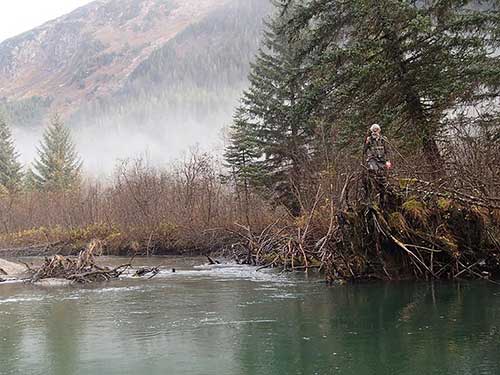
After a 16 year hiatus, I volunteered for my second trip with ADFG fishery biologists Leon Shaul and Scott Forbes to the headwaters of the Berners River north of Juneau. Leon is a world authority on coho salmon, having spent three decades studying the species over its range from Oregon to Russia, and this was his 32nd year on the Berners River trip. Leon and his staff practice hands-on fishery science. They count spawning coho salmon by stream walking in the fall.
In the spring, they capture juveniles migrating to sea, insert a numbered coded-wire tag into the young fish’s nose cartilage, and clip their adipose fin. When the fish return as adults, ADF&G staff examine the sport and commercial catch for coho salmon missing their adipose fin. The heads of these fish are sent to the ADF&G tag lab in Juneau, where the tag is removed from the head and read under microscope. The tag number indicates when and on which river a fish was tagged.
We drove to the end of the road north of Juneau, which ends in a cove of Berners Bay. A helicopter from Juneau met us there. The pilot landed and we loaded our gear into the helo’s cargo bag. The pilot hauled the cargo bag of our gear by sling up the river to the campsite, then returned for us at the parking lot.
We flew across Berners Bay and began to ascend the river. The pilot slowed the helo, and side-slipped up the river while Leon counted schools of coho salmon from the passenger’s seat. As Leon counted fish, Scott and I took in the view. We saw a pair of moose in the lower river wetlands, and later mountain goats in hillsides of the upper reaches of the river.
About an hour later, we reached the campsite and the pilot landed on a sandbar across from camp. We forded the river and began hauling our gear the short distance to our wall tent and home for the next 10 days. The platform for the tent is about 10 feet off the ground, with stairs that are removed when the camp is not in use. This keeps the large population of brown bears in the valley from destroying the camp in the 50 weeks when the camp is not in use. We hung the tent over its frame, set up the camp kitchen, tiny woodstove and stove pipe, and lit a fire to dry out the structure. A few hours later, Leon and Scott took off to start counting fish downriver while I finished setting up camp.
The headwaters of the river have several branches that split and rejoin, and Leon knows every one of them. Leon’s intimate knowledge of the river allows him to efficiently count fish down one branch of the river and then count fish on other branches on his return upstream with little backtracking. Scott and Leon walked downstream as far as they encountered fish, returning at dusk.
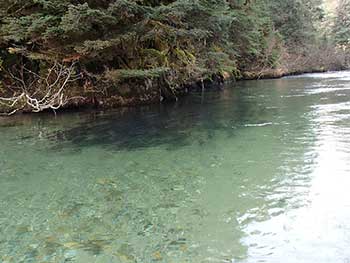
The next day, all three of us started upriver to count after a torrential rain overnight. At a fit 6’3”, Leon moves upstream at the same speed as he does downstream. I felt like I was running in chest waders for most of two weeks trying to keep up. Leon would send Scott and I up side channels while he walked another. At times, Scott and I wondered if we’d been sent up tributaries instead of a branch of the river, but of course, we always came back to the main stem, as Leon knew we would.
Late in the day, we came to the very headwater of the river, where it branched to its mountain sources on either side of the valley. Leon knew from past experience that from this point, fish only spawned in the right fork, so all three of us walked up that branch. This branch held many spawners in the river, and numerous parts and pieces of salmon left by bears along the banks. The trip upstream ended where the water literally came out of the mountain – my first trip to a river’s source. We ate lunch in the pouring rain along the mountainside, then began the long trek back to camp. When we reached the headwaters fork, it was late in the day and darkness was coming fast. The river had swollen significantly since we started up the branch at mid-day. We knew that once we crossed back to the camp-side of the river, we would have to travel overland because the water downstream would be too deep to wade – especially at night. As we trekked along the stream bank, dusk turned into night and we all donned headlamps to see. Up and down we went, crossing swollen tributaries feeding into the river, wading small lakes in the forest bottoms, then climbing up hillsides into open muskegs before descending back down into the woods again.
It would have been easy to pass our camp on this river of many branches in the middle of the night. Three hours later we finally dropped back to a trail along the river and suddenly, there was camp. It startled me in the weak light of my headlamp. Leon deftly escaped my attempt to hug him. We got a roaring fire going in the woodstove, made dinner and finally relaxed after an eventful day.
Seining coho
After completing a count of the spawning population, we began catching fish with a hand-hauled seine net. We moved from pool to pool with the seine, which Scott hauled in a garbage can strapped to a backpack. Each pool held its own challenges. Some had overhanging brush on one side of the creek. Others had tree stumps on the bottom that snagged the net. Current also was a factor. Leon had a strategy for each pool based on decades of trial and error. It might take several attempts for Scott and I to carry out Leon’s instructions to the letter, but once we did, we made fruitful hauls. For the next week, we made haul after haul in pool after pool to get a large, representative sample of the population – the hallmark of good science.
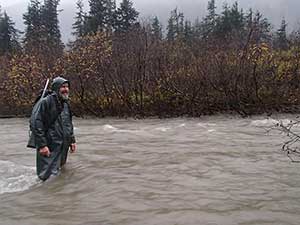
We plucked scales from fish so that the age of the fish could be determined from the rings on the scale. Although coho salmon spend one year at sea, they may spend one, two or three years in fresh water. In order to determine how many fish were produced in a given year, the age of the fish must be known to know which year it was born.
Another part of sampling was to determine what portion of the population was tagged as juveniles. As mentioned earlier, coho juveniles are caught and tagged in the spring. However, the total population is not caught, so the total number of juveniles that migrated in a year is not known, nor the fraction of the total tagged known. Therefore, when the fish return as adults, both the total number of smolts that migrated to sea and the fraction of those tagged can be estimated by looking at how many of the adults are tagged in the spawning population.
Remember that when the fish had coded-wire-tags inserted as juveniles, they also had their adipose fins removed. After collecting the spawners in the seine, we examined each fish caught in our seine for the presence of an adipose fin. The ratio of fin-clipped to unclipped adults was used as a multiplier to the number of tags recovered in the catch to form an estimate of the total number of fish from Berners Bay that were harvested. By adding the harvest to the number we counted in the spawning escapement, the total number of fish that survived to adulthood can be estimated. By assessing these returns year after year, Leon can recommend a range of spawning escapement that produces, on average, the largest return of adults. This range then becomes the escapement goal for the river.
Nomadic coho
The extensive coho salmon research program in Southeast Alaska also led to a remarkable discovery. Although coho salmon populations have been documented in over 3,000 streams in Southeast Alaska, many of these streams are tiny systems which cannot support a “closed” population, i.e., a population that grows from egg to smolt before leaving the stream. This might lead to the conclusion that spawners in these systems were perhaps strays from other watersheds and that any juveniles produced would not survive in the tiny systems. Through coded-wire-tagging, Leon discovered that coho salmon fry are able to move to saltwater during the summer, when feed is abundant in estuaries, and then return to freshwater in the fall to overwinter before finally moving to the sea fulltime as smolts the following spring. This is quite a feat of evolutionary adaptability for the salmon to be able to readily move back and forth for extended periods between fresh and salt water. Even more interesting was the finding that some Chilkat River coho juveniles, after entering saltwater near Haines, did not return to the Chilkat River, but traveled some 40 miles south and ascended the Berners River to overwinter before going to sea the following spring.
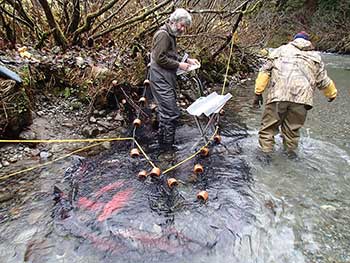
In addition, three smolts tagged in the Berners River ended up returning as adults to spawn in the Chilkat River. In the past, these fish may have been thought to be strays – fish returning to spawn in a river different from where they hatched. Leon’s research has shown that this may not always be the case, and that in fact the marine-rearing “nomads” may eventually return to their natal stream to spawn. These movements of young fish between drainages demonstrate some of the evolutionary adaptability of coho salmon, providing insight as to how the species fully utilizes isolated freshwater habitats and may expand its range during geologic and environmental events such as glacial retreat, earthquakes, and warming trends in the Alaska arctic.
According to Leon, the long-term data series is providing insight into effects of climate and fluctuations in high seas prey on coho salmon returns in Southeast Alaska. Until the mid-2000s, Berners River coho smolt production was strongly related to precipitation in summer and fall of the year before migration to sea. Years of higher precipitation creates an extensive wetland that increases the amount of habitat available to rearing coho salmon. Cooler temperatures in recent years, however, have appeared to limit smolt production, even after ample rainfall. Similar cooler temperatures seen from the 1950s until the late-1970s resulted in reduced returns of coho salmon in the Berners River and other streams in the area, while favoring salmon populations further south in Canada and the Lower 48. Coho returns began to improve a few years after the return to warmer sea temperatures in 1977, and the Berners River stock reached a period of peak abundance during 1990-2004. With the recent cooler ocean temperatures, coho returns have again declined.
Even-odd returns and the squid factor
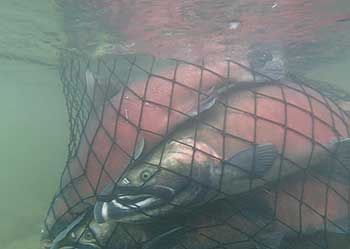
Leon’s research indicates that not only have coho returns declined to the Berners River with cooling temperatures, but so has the size of coho salmon returning to spawn. Spawners have declined by 8 percent in average length and 25 percent in average weight between 1982–1983 and 2012–2013. In addition, fish returning in odd years are substantially smaller than those returning in even years. As they enter their second season at sea, coho salmon depend primarily upon the minimal armhook squid for concentrated calories. Coho can put on weight faster than any other species of Pacific salmon, and can weigh up to 20 pounds when they return to spawn. . Leon developed a model that explains much of the year-to-year variation in coho salmon size since 1970, based on changes in Pacific Decadal Oscillation (an index of the temperature pattern in the North Pacific), and the abundance of pink salmon in the Gulf of Alaska. The findings suggest that survival of squid is poor during cold periods like the present, and that increasing pink salmon predation is another factor controlling squid populations, primarily in odd years when pinks have been more abundant. Pink salmon feed primarily on zooplankton during most of their marine residence, but consume substantial quantities of squid during their final summer at sea. As the average size of Berners River coho spawners has declined and become increasingly cyclic between even and odd years, survival of smolts to adulthood has been lower in years when spawners are both smaller and show a lower female to male ratio. While most marine mortality of salmon is thought to occur very early after sea-entry, these findings suggest that mortality during later ocean residence may be increasingly influential in determining the abundance of returning adults.
While coho populations at the Berners River fluctuate over time, escapement goals have been consistently met over the past 30 years through conservative fisheries management. The Berners River coho project exemplifies how some of the more difficult but important scientific questions about fisheries are addressed through decades of routine counting and measurement, a strategy that benefits all who have an interest in the resource.
Mark Stopha is a fishery biologist with the Division of Commercial Fisheries at ADF&G headquarters in Juneau.
Subscribe to be notified about new issues
Receive a monthly notice about new issues and articles.
